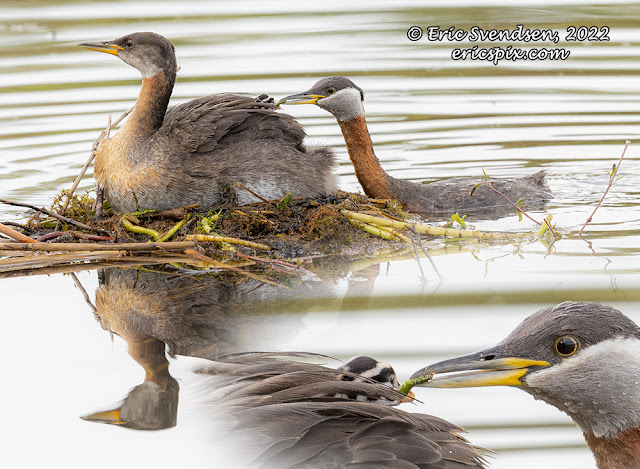Red-necked grebe parents and chick
Grebes have always fascinated me. Whenever I see one I take a moment to watch its behaviour. There are four species in western Canada that I commonly see; red-necked, western, eared, and pied-billed. Of these four species, the ones I see most often are the red-necked variety.
While hiking around Broadmore Lake Park in mid-June I saw a red-necked grebe sitting on a nest made out of aquatic vegetation. They pile up floating plants until a mound is built that is high enough to sustain an adult and brood. As I watched another grebe approached with something in its beak. I was surprised at what happened next.
Nestled under the wings of the first parent (female I think) was a young chick. They are quite comical in appearance with their bold black and white striped pattern enhancing their already significant level of cuteness. As the second grebe (male) slowly moved towards his mate a ball of puff emerged from warmth seclusion and awaited the approaching morsel.
As I watched (and photographed) the unfolding event I was in awe by the gentle manner in which the adult fed this young bird. It was with great care and precision that the meal was delivered. Immediately after this avian display of tenderness took place, the meals on wheels (fodder from father?) component left to search for another bite.
I was interested to see that the parent brought an insect to its young and not a fish as so many other fish-eating birds do for their young. There was not the usual regurgitation of semi-digested prey one usually expects to see in this instance. Apparently, grebes are only too happy to search out soft, squishy bits of protein that will feed their young. I expect that minnows may also be on the menu.
It was a wonderful thing to watch the exchange take place. I was only too happy to witness it all and get some meaningful photos. I want to point out that I kept my distance the entire time and was somewhat hidden by a low bush. The fact I was using a 500 mm lens on a crop-sensor body (750 mm relative) aided in that achievement. It is important not to disturb wildlife, especially during the breeding season.
Thanks for reading. www.ericspix.com




Comments
Post a Comment